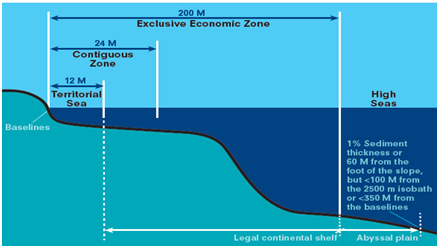

|
Activities allowed in EEZ:–
|
Context
According to the Indian Navy, more than 200 Chinese fishing vessels have been monitored in the Indian Ocean in the year 2022, which further highlights theillegal, unreported and unregulated (IUU) activities to continuerising beyond India’s Exclusive Economic Zone (EEZ).
About
What is an Exclusive Economic Zone (EEZ)?
- The EEZ is an area that is adjacent to and beyond the territorial sea.It can extend to a maximum of 200 nautical miles from the baseline.
- The baseline is normally measured is the low-water line along the coast as indicated on large-scale charts officially approved by the coastal state.
- The EEZ does not include the territorial sea and also does not include the continental shelf beyond 200 nautical miles.

Threats for India
- India territory with huge coastline is vulnerable to the threats emerging from maritime domain.
- Maritime terrorism (Mumbai attack of 26/11)
- China is rising, emerging as a serious challenger.
- Other issues: Piracy, Terrorism, Illegal migration, Transnational Organised crimes, Environmental Concern
|
Governance of coastal security: Currently, coastal security of India is governed by a three-tiered structure.
|
Why maritime security is important for India?
- Water for trade:India’s major import and exports is carried out through the maritime water, thus enhancing the importance of securing coastlines is imperative of economic growth.
- Maritime threats:India’s huge coastlines, around 7000km, increases the vulnerability to maritime threats as testified by 26/11Mumbai attacks.
- Blue economy:One of the major economic activities of the coastal states of India, comprising around 4% of the Indian economy, with an immense future potential.
- Strategic Factor:Increasing Chinese influence and assertiveness in the Indian Ocean Region providing a potential threat to the India’s regional interest.
- Ocean resource security and management of resources.
Mechanism available for combating maritime security:
- United Nations Convention on the Law of the Sea (UNCLOS)provides a framework regarding rights and responsibility of the nations over international waters.
- SAGAR (Security and Growth for All in the Region) Doctrine: Indian initiative, aims to deepen the economic and security cooperation with its maritime neighbours, along with enhancing their security capabilities.
- Indo-Pacific Oceans’ Initiative (IPOI)
- QUAD initiative to ensure safe, secure and free Indo-Pacific region.


